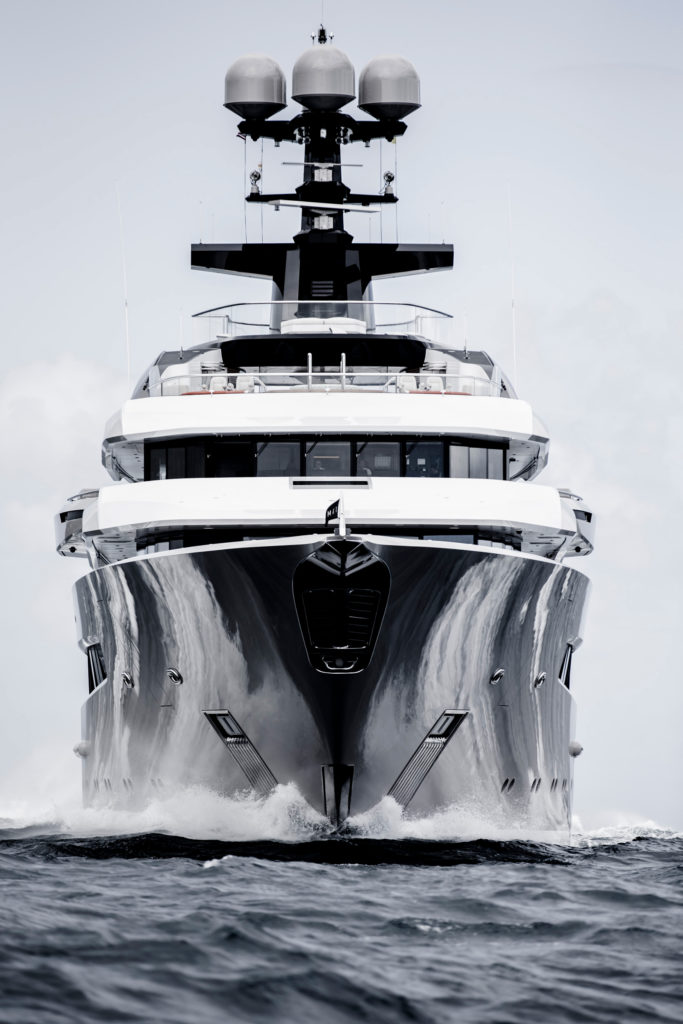December 13th, 2021

Coral Ocean Yacht by Lürssen, developed and sold by Moran Yacht & Ship. Courtesy Moran Yacht & Ship
As the outdoors have become the safest place to enjoy a respite from our otherwise socially isolated summers, boat owners are evermore grateful for the freedom to extend their vicinity into the many miles of open waters. After all, this isn’t entirely new; true boat lovers have always found relief and tranquility in the humming bays and wild sea, if nothing else as a short-term escape from the inflexible solidity of life on land.
In order to provide that full experience, owners have always sought to offer their families and guests the most luxurious accommodations. For many, this means commissioning a brand new, custom yacht construction, built to specific engineering and design preferences.
BUILD TIME
A yacht’s dimensions determine everything from its engine capacity to its amenities to its build time. Here’s how long you should expect all engineering and design details to be defined before a new build is delivered.
SUPER YACHT:
Length: 80-120 ft (24-36 M)
Average Build Time: 1.5 years
Accommodations: 6-12 guests
MEGA YACHT:
Length: 120-220 ft (36-68 M)
Average Build Time: 2.5 years
Accommodations: 12-36 guests
GIGA YACHT:
Length: 220 ft+ (68+ M)
Average Build Time: 4 years
Accommodations: 36+ guests
But while the prospect of a custom-built boat may sound as much a dream as a summer day sailing one, the intricate and long-term process can take many wrong turns. When contracting construction with a standard broker who deals directly with shipyards, many owners end up paying 20 to 40 percent more than the original contract price. For some, that translates to $60 million extra in renovations on a brand-new construction.
“Shipyards are purely in the business of making money,” says Robert Moran, founder and President of Moran Yacht & Ship, a luxury superyacht construction and brokerage firm. There’s a conflict of interest between the manufacturer and the customer in the industry, he explains, where shipyards have the incentive to write the yacht’s technical specifications in such a way to encourage additional change-order revenue. To avoid this, planning, mapping, and building 3D renderings of a ship before a single material is ordered is of the utmost importance. Moran and others experts in automotive engineering and interiors shared with us how to get it right the first time.

Kismet Yacht by Lürssen, developed and sold by Moran Yacht & Ship. Courtesy Moran Yacht & Ship
ENGINEERING FOR THE FUTURE
Robert Moran’s insight comes from his thirty-three years of experience constructing superyachts, a category of ships whose lengths generally reach over 80 feet and include ultra-luxurious interiors and amenities. As a seasoned builder, Moran and his team are able to anticipate every permutation of the thousands of decisions and variables that arise when building a new yacht from the ground up.
“When you’re writing the techs, you’re writing for the future,” says Moran. “You have to write for new green tech, the power saving equipment. That’s glass, solar panels, et cetera.
In addition to green tech, other spec variations that owners must choose include types of insulation, engine equipment, air conditioning systems, rating systems, and interior choices like fabric, wood and marble. Due to the laser-like attention to detail that is required to ensure every one of those thousands of decisions are correct, Moran Yachts oversees construction of only two to four ships per year.
“If you’re writing specifications that match today’s standard, you’re already building for the past.”
INTERIORS MUST BE TIMELESS
A chille Salvagni, a renowned interiors and furniture designer for yachts and homes, explains, “Most shipyards would either treat interiors as a creativity aspect and assign it completely to the novice buyer, or they would leave it to the technicians at the shipyard itself, as if it were a secondary part to deal with.” Being the most lived-in and used aspect of the yacht, interiors largely determine the ship’s entire value over time.
Trendy interiors can result in a faster devaluation. As the lead interior designer on the latest Grande Series for world renowned yacht maker, Azimut, Salvagni emphasizes the need for creating his clients’ builds using understated, timeless tones and lines.

Kismet Yacht by Lürssen, developed and sold by Moran Yacht & Ship. Courtesy Bespoke Luxury Marketing and Guillaume Plisson
“A yacht is rootless,” he explains, which creates a unique design challenge. Yacht construction, unlike that of a plane or car, incorporates residential aspects, and yet unlike a home, has no identity defined by its fixed surroundings. “You cannot overdress the interior. If you do, it might match one specific scene but not ninety percent of the rest of the scenes. My attention is to create a very neutral space that matches the needs of the clients, embodies the DNA of the owners, but still is neutral enough to absorb and to create a dialogue with different scenarios,” he says. “The more neutral you are, the longer the yacht will last.”
3D VISION
Top construction and design firms are increasingly relying on 3D renderings to ensure alignment between their vision and the customer’s over those many years of planning. Only recently has rendering technology become robust and realistic enough to allow engineers and designers to organize, manage, and envision the millions of technical decisions with groundbreaking precision. In fact, the models can be so identical to reality that many publications have mistakenly published renderings as though they were real images.
Because of the tedium and massive scale that is yacht construction, it is crucial that shipyards, brokers, and designers predefine all engineering and interior specifications at least one year before the piece is delivered, and sometimes even longer depending on the dimensions; a “giga-yacht”, one that spans over 220 feet, can require up to four years of detailed definition in advance. If they don’t, advises Salvagni, “Run.”
When building a boat, some owners end up paying 20 to 40 percent more than the asking price, which can translate to an extra $60 million.
NO ROOM FOR RENOVATIONS
It is precisely because of today’s ability to plan construction to near exactitude that both Moran and Salvagni advise clients not to approach yacht construction like they would home construction. While home renovations, such as putting up new walls or replacing ventilation systems, are relatively straight-forward, tweaks on a yacht are insensibly expensive.

Launch of Project Testarossa by Lürssen. Courtesy Moran Yacht & Ship
Because the value of any motorized vehicle depreciates over time, the costs of renovations would not increase a ship’s value enough to even slightly make up for its depreciation. It therefore makes more sense for owners to sell their yachts and build a new one from scratch than renovate. For that reason, 3D renderings avoid such dilemmas and ensure the first construction matches the initial contracting cost.
“To any potential yacht owner, to any potential yacht builder,” advises Moran, “find the company that has sold and built for a long period of time the type of yacht you’re building. They’ve got to know a lot. And that type of knowledge is the only way to create and build at the highest level.”





